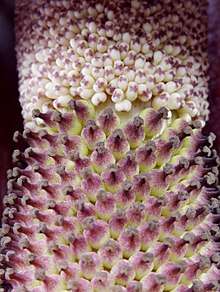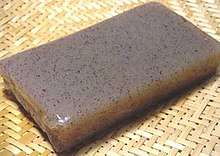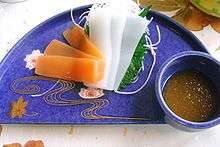Konjac
Konjac (or konjak, English: /ˈkɒnjæk, ˈkɒndʒæk/ KON-yak, KON-jak) is a common name of the East and Southeast Asian plant Amorphophallus konjac (syn. A. rivieri), which has an edible corm (bulbo-tuber). It is also known as konjaku, konnyaku potato, devil's tongue, voodoo lily, snake palm, or elephant yam (though this name is also used for A. paeoniifolius).
| Konjac Amorphophallus konjac | |
|---|---|
 | |
| Scientific classification | |
| Kingdom: | Plantae |
| Clade: | Tracheophytes |
| Clade: | Angiosperms |
| Clade: | Monocots |
| Order: | Alismatales |
| Family: | Araceae |
| Genus: | Amorphophallus |
| Species: | A. konjac |
| Binomial name | |
| Amorphophallus konjac | |
| Synonyms[1] | |
| |
It is native to Yunnan in China and cultivated in warm subtropical to tropical East and Southeast Asia, from Japan and China south to Indonesia (USDA hardiness zone 6-11). It is a perennial plant, growing from a large corm up to 25 cm (10 in) in diameter. The single leaf is up to 1.3 m (4 ft) across, bipinnate, and divided into numerous leaflets.[2] The flowers are produced on a spathe enclosed by a dark purple spadix up to 55 cm (22 in) long.
The food made from the corm of this plant is widely known in English by its Japanese name, konnyaku (yam cake), being cooked and consumed primarily in Japan and Korea. The two basic types of cake are white and black. Noodles made from konnyaku are called shirataki. The corm of the konjac is often colloquially referred to as a yam, though it is not related to tubers of the family Dioscoreaceae.
History
Native names:
- Japanese: こんにゃく/コンニャク/蒟蒻/菎蒻 konnyaku;
- Korean: 곤약 gonyak;
- Chinese: 蒟蒻; pinyin: jǔruò; Jyutping: geoi2 joek6
Wild forms grow naturally in Southeast Asia and China.[3] Konjac has been known in Japan since the sixth century as a medicinal food.[4] During the Edo period (beginning in the early 17th century), the Japanese imported konnyaku from China.[5] The 1846 book Konnyaku Hyakusen (‘100 recipes of konnyaku’) demonstrates its popularity in Japan at that time.
Cultivation and use
.jpg)



Konjac is grown in East Asia (China, Korea, Taiwan, Japan) and Southeast Asia for its large starchy corms, used to create a flour and jelly of the same name. It is also used as a vegan substitute for gelatin.
Japan and China
In Japanese cuisine, konjac (konnyaku) appears in dishes such as oden. It is typically mottled grey and firmer in consistency than most gelatins. It has very little taste; the common variety tastes vaguely like salt, usually with a slightly oceanic taste and smell (from the seaweed powder added to it, though some forms omit the seaweed). It is valued more for its texture than flavor.
Ito konnyaku (糸蒟蒻) is a type of Japanese food consisting of konjac cut into noodle-like strips. It is usually sold in plastic bags with accompanying water. It is often used in sukiyaki and oden. The name literally means "thread-konjac".
Japanese konnyaku is made by mixing konjac flour with water and limewater.[6] Hijiki is often added for the characteristic dark color and flavor. Without additives for color, konjac is pale white. It is then boiled and cooled to solidify. Konjac made in noodle form is called shirataki and used in foods such as sukiyaki and gyūdon.
Konjac is consumed in parts of China's Sichuan province; the corm is called moyu (Chinese: 魔芋; lit.: 'magical taro'), and the jelly is called "konjac tofu" (魔芋豆腐 móyù dòufu) or "snow konjac" (雪魔芋 xuě móyù).
Health claims
The dried corm of the konjac plant contains around 40% glucomannan gum. This polysaccharide makes konjac jelly highly viscous and may be responsible for many of its putative health benefits as used in traditional Chinese medicine, detoxification, tumour-suppression, blood stasis alleviation and phlegm liquefaction.[7] The dietary fiber from the corm of konjac is used as a component of weight loss supplements.[8]
Fruit jelly
Konjac can also be made into a popular East Asian fruit jelly snack, known variously in the United States as lychee cups (after a typical flavor and nata de coco cube suspended in the gel) or konjac candy, usually served in bite-sized plastic cups.
Choking risk
Perhaps because of several highly publicized deaths and near-deaths in the San Francisco Bay Area among children and elderly caused by suffocation while eating konjac candy, the U.S. Food and Drug Administration (FDA) issued product warnings[9] in 2001, and there were subsequent recalls in the United States and Canada. Choking and intestinal blockage risk warnings have been published at more recent websites.[10]
Unlike gelatine and some other commonly used gelling agents, konjac fruit jelly does not melt readily in the mouth. Some products form a gel strong enough to require chewing to disintegrate the gel. Though the product is intended to be eaten by gently squeezing the container, a consumer can suck the product out with enough force to unintentionally lodge it in the trachea. Because of this hazard, the European Union and Australia banned Konjac fruit jelly.[11][12][13][14]
Some konjac jelly snacks are not of a size and consistency that pose a choking risk, but are nonetheless affected by the government bans.[15] Some products that remain in East Asian markets have an increased size, unusual shape, and more delicate consistency than the round, plug-like gels that were associated with the choking incidents. The snacks usually have warning labels advising parents to make sure their children chew the jelly thoroughly before swallowing.
Japan's largest manufacturer of konjac snacks, MannanLife, temporarily stopped producing the jellies after a 21-month-old Japanese boy choked to death on a frozen MannanLife konjac jelly.[16] 17 people died from choking on konjac between 1995 and 2008.[17] MannanLife konjac jelly's packaging bag now shows a note to consumers, advising them to cut the product into smaller pieces before serving it to small children.
Vegan seafood alternative
Konjac corm powder has a noticeable 'fishy' smell and is used as an ingredient in vegan alternative seafood products.[18] It can be incorporated into animal-product-free versions of scallops, fish, prawns (shrimp), crab, etc. For Chinese cooking, thin strands of konjac gel can be used as substitute for shark fins when preparing an imitation version of the shark fin soup.[19][20]
Other uses
Konjac can also be used for facial massage accessories, which are currently popular in Korea and gaining popularity in the West. Most commonly this is through the use of a konjac sponge, which is unique in that it can be used on sensitive skin that may become easily irritated with more common exfoliating tools (such as loofahs or washcloths).
In traditional hand papermaking in Japan, konnyaku imparts strength to paper for dyeing, rubbing, folding—and other manipulations, such as momigami.[21]
See also
References
- "Amorphophallus konjac K.Koch". World Checklist of Selected Plant Families (WCSP). Royal Botanic Gardens, Kew. Retrieved 8 January 2016 – via The Plant List.
- "Amorphophallus Konjac". Archived from the original on 2014-08-21. Retrieved 2014-08-20.
- "Konnyaku de-mystified". Hints for the Home. 2014.
- Honzō Wamyō (本草和名)
- "About Us - History of Shirataki Noodles". Miracle Noodle.
- "How to make konjac foods (shirataki noodles or konyaku) myself".
- Chua, M; Baldwin, TC; Hocking, TJ; Chan, K (24 March 2010). "Traditional uses and potential health benefits of Amorphophallus konjac K. Koch ex N.E.Br". Journal of Ethnopharmacology. 128 (2): 268–78. doi:10.1016/j.jep.2010.01.021. PMID 20079822.
- "Amorphophallus Konjac & Weight Loss". Calorie-Count.US. Retrieved 2013-07-09.
- FDA issues a second warning and an import alert about konjac mini-cup gel candies that pose choking risk, FDA News P01-17, 5 October 2001
- "Glucomannan: Uses, Side Effects, Interactions, Dosage, and Warning". www.webmd.com. Retrieved 2019-08-28.
- "Directive of the European Parliament and of the Council amending Directive 95/2/EC as regards the conditions of use for a food additive E 425 konjac" (PDF). food.gov.uk. Retrieved 8 April 2018.
- Draft Commission Decision (SANCO/362/2002) suspending the placing on the market and import of jelly confectionery containing food additive E 425 Konjac, UK Food Standards Agency, 8 March 2002
- Mini fruit gel sweets containing konjac, UK Food Standards Agency, 8 July 2003
- Product Safety Australia for Triko Fibrous Fruit Jelly describing that "Jelly cups containing konjac are permanently banned in Australia", ACCC, 5 October 2017
- Australia, Product Safety (2015-11-30). "Mini jelly cups containing konjac". Product Safety Australia. Retrieved 2019-10-05.
- Yomiuri,
- Article from the Japan Times, "Food maker pulls 'konyaku' sweets", October 9, 2008
- "Wake up and smell the konjac". March 3, 2015. Archived from the original on 2019-01-21.
- Kho, Kian (2015). Phoenix Claws and Jade Trees: Essential Techniques of Authentic Chinese Cooking. New York: Clarkson Potter. p. 278. ISBN 9780385344692.
- Kho, Kian. "Banning Shark Fins from Shark Fin Soup". Red Cook. Retrieved 5 September 2016.
- "Wet Strength: The Use of Konnyaku in Hand Papermaking". Retrieved 30 March 2017.
